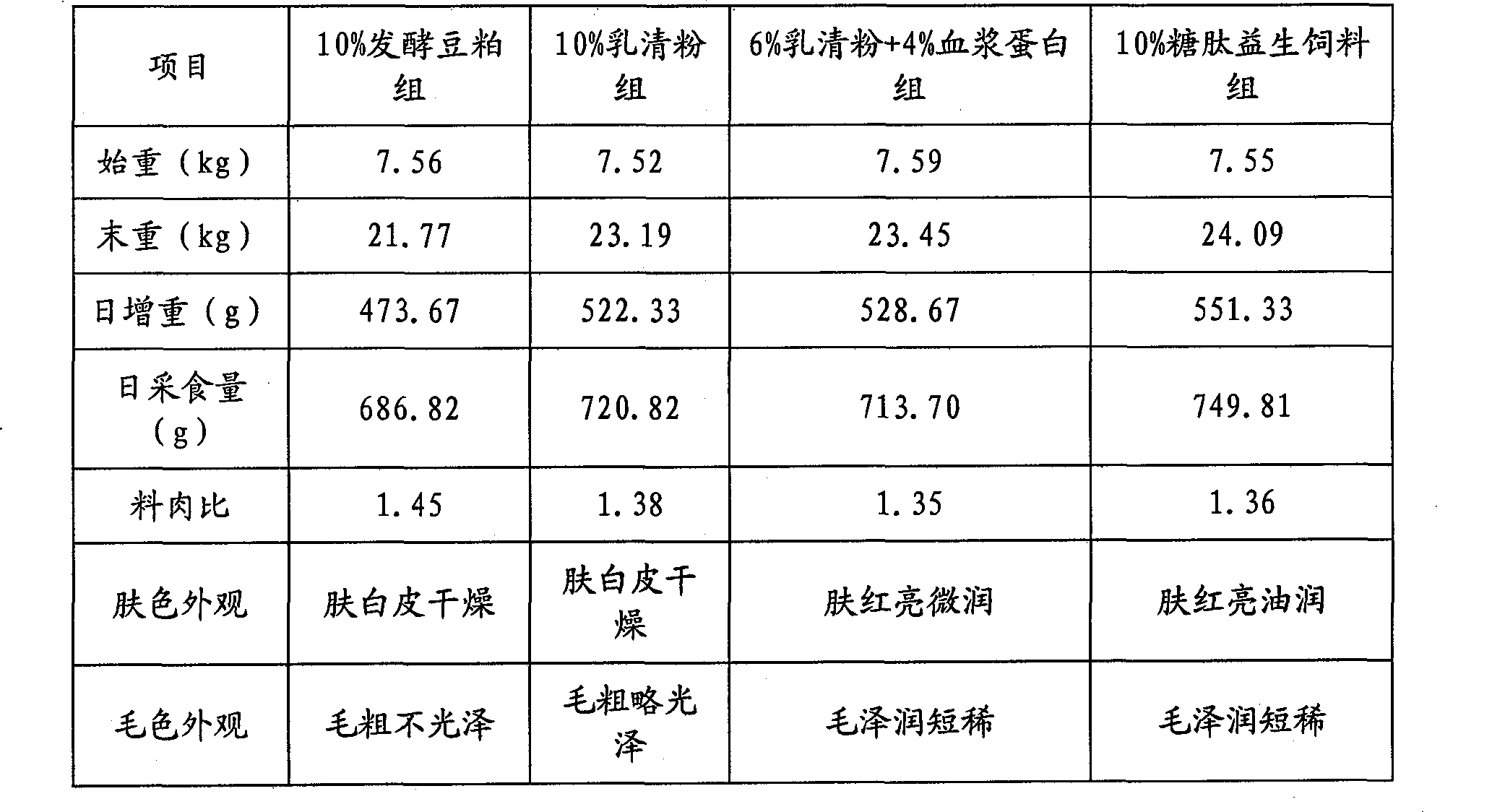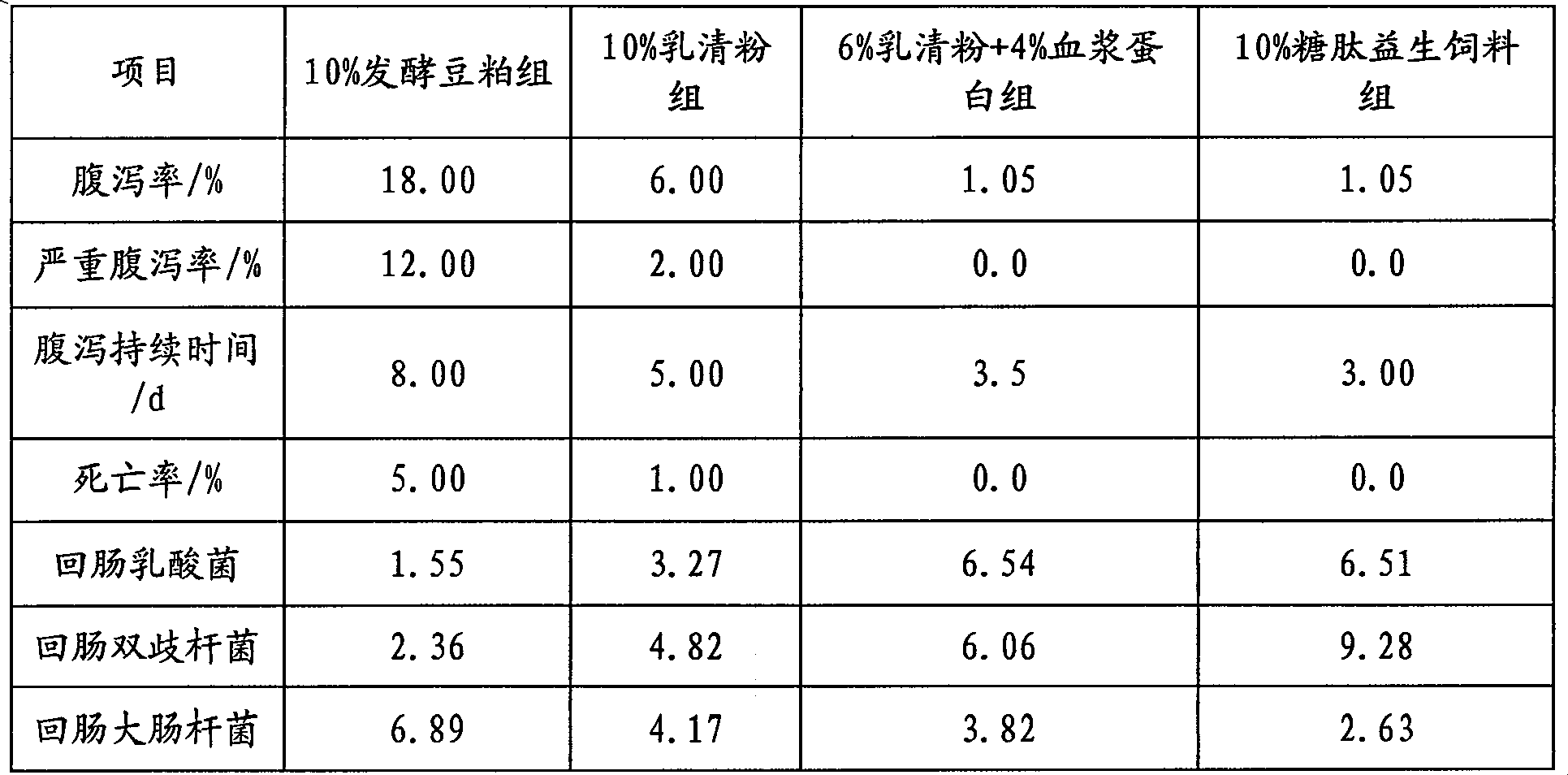Method of making fodder for young livestock
A technology for livestock and poultry feed and young age, applied in the field of enzyme preparations, microorganisms, and feed, can solve the problems of volatile gastrointestinal microflora, increased osmotic pressure of intestinal contents, and unsound digestive tract function, and achieve palatability. Good sex, easy to digest, amino acid balance effect
- Summary
- Abstract
- Description
- Claims
- Application Information
AI Technical Summary
Problems solved by technology
Method used
Image
Examples
Embodiment 1
[0027] 600kg of corn, 100kg of wheat, 200kg of broken rice, 50kg of soybeans and 50kg of soybean meal were removed and pulverized, mixed evenly, and then 1500kg of water was added to prepare an enzymatic hydrolysis slurry, heated to 80-50°C to liquefy, and liquefied with 20% sodium hydroxide solution Adjust the pH to 6.0-6.2, add 2kg of a-amylase at a dry basis of 0.5-25U / g substrate, enzymatically hydrolyze for 0.2-1h, adjust the pH to 4.5-4.6 with 20% sulfuric acid solution, add 2U / g substrate 2kg of glucoamylase, 1kg of xylanase of 10U / g substrate, 0.5kg of dextranase of 0.5U / g substrate and 0.5kg of microbial protease of 20U / g substrate. Desaccharification for 24-48 hours, drying to make A component.
[0028] After removing impurities and crushing 200kg of soybean meal, add 150kg of water, mix evenly, heat up to 38-40°C, add 10kg of yeast seed liquid, 10kg of lactic acid bacteria seed liquid and 10kg of Bacillus licheniformis seed liquid; press 500U / g Add 0.5 kg of microb...
Embodiment 2
[0031] Remove impurities and grind 7000kg corn, 500kg wheat, 2000kg broken rice and 500kg soybean meal, mix them evenly, then add 20000kg water to prepare an enzymolysis slurry, raise the temperature to 85-90℃ for liquefaction, and adjust the pH to 6.2~6.5, add 20kg of a-amylase according to 0.5~25U / g substrate dry basis, enzymatic hydrolysis for 0.2~1h, adjust the pH to 4.6~5.0 with 20% sulfuric acid solution, add 0.1U / g substrate for saccharification Enzyme 20kg, 100U / g substrate xylanase 5kg, 0.1U / g substrate dextranase 2.5kg and 0.2U / g substrate microbial protease 2.5kg, enzymolysis at 100°C Saccharify for 24-48 hours, and dry to make component A.
[0032] After removing impurities and crushing 2000kg of soybean meal, add 1200kg of water, mix evenly and heat up to 38-40°C, add 100kg of yeast seed liquid, 100kg of lactic acid bacteria seed liquid and 100kg of Bacillus licheniformis seed liquid; press 500U / g Add 4kg of microbial protease to the substrate, mix evenly, anaero...
Embodiment 3
[0035] Remove impurities and pulverize 300kg corn, 30kg wheat, 150kg broken rice and 20kg soybean meal, mix well, then add 800kg water to prepare enzymatic hydrolysis slurry, heat up to 40-60°C to liquefy, and adjust the pH to 4.5~6.0, add 1kg of a-amylase at 0.5~25U / g substrate dry basis, enzymolysis for 0.2~1h, adjust the pH to 3.0~4.5 with 20% sulfuric acid solution, add 100U / g substrate glucoamylase 1kg, 0.5U / g substrate xylanase 0.2kg, 600U / g substrate dextranase 0.1kg and 1U / g substrate microbial protease 0.3kg, enzymatic hydrolysis and saccharification at a temperature of 80°C 24~48h, dry to make A component.
[0036] After removing impurities and crushing 200kg soybean meal, add 120kg water, mix evenly, heat up to 38-40°C, add 12kg yeast seed liquid, 12kg lactic acid bacteria seed liquid and 6kg Bacillus licheniformis seed liquid; press 500U / g Add 0.5 kg of microbial protease to the substrate, mix evenly, anaerobically ferment and enzymatically hydrolyze for 24-48 hou...
PUM
 Login to View More
Login to View More Abstract
Description
Claims
Application Information
 Login to View More
Login to View More - R&D
- Intellectual Property
- Life Sciences
- Materials
- Tech Scout
- Unparalleled Data Quality
- Higher Quality Content
- 60% Fewer Hallucinations
Browse by: Latest US Patents, China's latest patents, Technical Efficacy Thesaurus, Application Domain, Technology Topic, Popular Technical Reports.
© 2025 PatSnap. All rights reserved.Legal|Privacy policy|Modern Slavery Act Transparency Statement|Sitemap|About US| Contact US: help@patsnap.com



